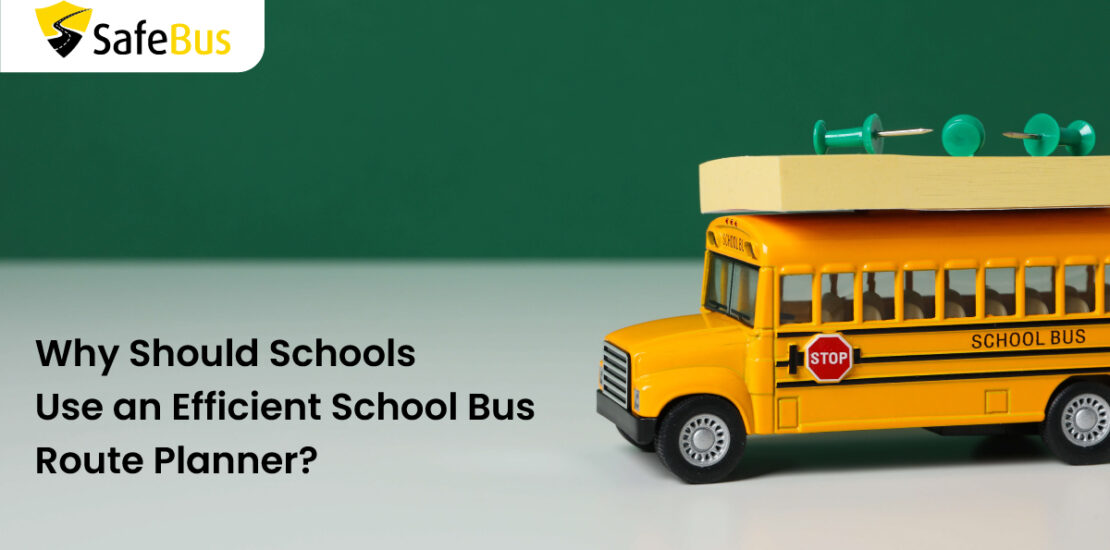- October 19, 2023
- Posted by: SafeBus Marketing
- Category: Blog

While offering school transportation to students, the goal is clear: provide safe, timely, and cost-effective transportation. However, achieving this goal becomes challenging, especially when schools have to manage a large number of students, buses, drivers, and routes. Student safety is indeed a priority, but in the cases of school transportation, cost, and time-saving take a back seat majorly because of manual operations and its inefficiencies.
In this scenario, automation through a school bus management system can be highly beneficial for schools. In this blog, let’s explore an aspect of automation in the form of school bus route planners and how it can benefit schools.
What is a School Bus Route Planner?
School bus route planner is a major functionality of a school bus management system that automates and streamlines the process of planning and managing school bus routes. It is an invaluable tool for educational institutions and transportation providers, as it assists in the efficient organization of school bus schedules, helping them to ensure that students are transported safely and punctually. The route planner takes into account various factors, including student addresses, traffic conditions, bus capacity, and more to create the most efficient and cost-effective routes.
Automating the route planning process reduces manual workloads, minimizes transportation costs, and improves overall service quality. It ensures that students reach school and their homes in the shortest time possible.
How Does a School Bus Route Planner Work?
A school bus route planner like SafeBus starts by collecting relevant data, including student addresses, bus stop locations, road maps, and traffic data. Using advanced algorithms and data analysis, the planner then identifies the most efficient routes to minimize traveling distance, time, and fuel consumption. Additionally, SafeBus can also work on pre-designed school bus routes and optimize them to achieve maximum efficiency. Further, to optimize routes, SafeBus considers various factors such as the number of stops, the sequence of stops, and the capacity of each bus. The goal is to create routes that are as short and direct as possible, ensuring cost savings and punctuality.
It is also essential for schools to understand that route planning isn’t a one-time task. A school bus route planner continually updates routes to adapt to changes in student enrollment, road conditions, and other variables. This dynamic approach ensures that the transportation system remains efficient and responsive to evolving needs. Also, for achieving more efficiency, parents must provide clear and updated route information to know from where and when the children will be picked up and dropped off. It also assists bus drivers in adhering to the routes and schedules, enhancing the overall reliability of the transportation system.
Benefits of a School Bus Route Planner
Implementing a school bus route planner offers numerous benefits to school transport managers and administrative heads:
Cost Savings
Optimized bus routes can lead to significant cost savings for schools. By reducing the distance and time buses travel, schools can save on fuel expenses, maintenance costs, and even the need for additional vehicles. Additionally, efficient routes can minimize labor costs and the need for extra staff, further contributing to cost savings.
Better Resource Allocation & Utilization
Efficient route planning enables schools to allocate their resources more effectively. Schools will need less transport staff and school buses. It allows schools to allocate resources for other critical areas, such as curriculum development and extracurricular activities.
Student Safety
Ensuring the safety of students during their commute to and from school is the foremost concern for school transport managers. Efficient route planning can minimize the time students spend on buses, reducing tiredness, travel exertion, and other health issues. This will allow students to reach school with a fresh mind and focus more on learning. Moreover, it also reduces the potential for accidents, enhancing overall safety. Shorter routes also mean fewer opportunities for distractions and discipline issues among students.
Reduced Environmental Impact
Efficient route planning not only saves money but also reduces the environmental footprint of school transportation. Less time on the road means reduced fuel consumption and emissions. In an era of increasing environmental awareness, schools can demonstrate their commitment to sustainability by adopting eco-friendly transportation practices such as efficient use of shared mobility.
Improved Punctuality
A well-optimized bus route helps buses arrive at their stops and destinations on time. This is crucial for students and parents who entirely rely on school buses for their children’s safe return to home. This punctuality can be a key factor in building and maintaining positive school-parent relationships.
Conclusion
Efficient school bus route planning is a crucial aspect of school transportation management. By using a school bus route planner, school transport managers and administrative heads can optimize routes to save both cost and time. In addition to saving costs and time, a school bus route planner also helps enhance student safety, improve student punctuality, achieve environmental sustainability, and allocate resources more effectively.
